Having problems reading this email? View it in your browser >>
|
||
 |
||
|
||
Contents
|
||
More evidence to support recycling tenofovir in second-line treatment | ||
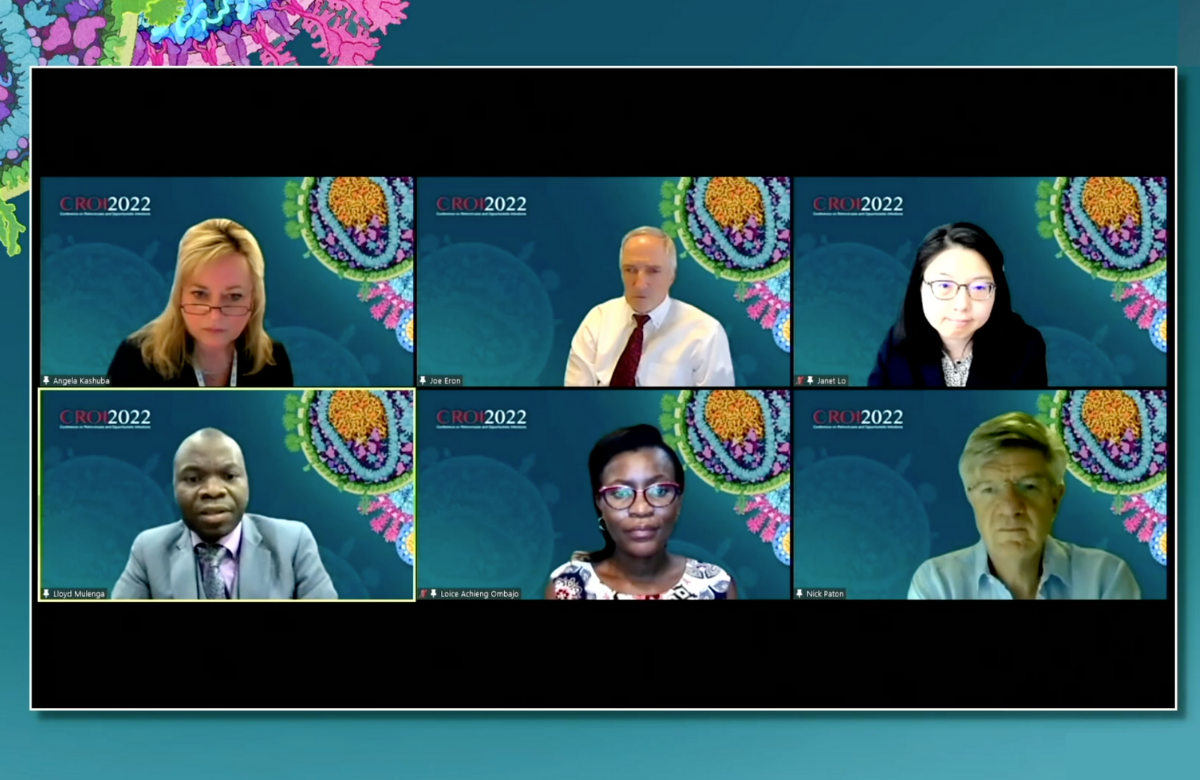 Dr Lloyd Mulenga (bottom left) and Professor Nick Paton (bottom right) at CROI 2022. | ||
|
Dr Lloyd Mulenga and Professor Nick Paton presented results from two studies in sub-Saharan Africa to the Conference on Retroviruses and Opportunistic Infections (CROI 2022) Current World Health Organization guidelines recommend the use of dolutegravir in second-line treatment in resource-limited settings. They also recommend including a new nucleoside analogue in the regimen. As most people on first-line treatment take tenofovir, this means switching to zidovudine, which is less well tolerated. The VISEND study recruited 1201 participants in Zambia who were taking a failing NNRTI-based regimen that contained tenofovir and lamivudine. In arm A of the study, 418 participants with a viral load below 1000 were randomised to receive either a ‘TLD’ combination, containing tenofovir disoproxil (TDF) and lamivudine with dolutegravir or a ‘TAFED’ combination, containing the newer formulation of tenofovir (tenofovir alafenamide; TAF) and emtricitabine with dolutegravir. In arm B, 783 participants with a viral load above 1000 were randomised to take either TLD, TAFED, zidovudine/lamivudine plus atazanavir/ritonavir, or zidovudine/lamivudine plus lopinavir/ritonavir. At week 48, in arm A, 76% of those assigned to TAFED and 81% of those assigned to TLD had a viral load below 50. In arm B, 82% of those taking TAFED, 72% on TLD, 71% on atazanavir/ritonavir and 56% on lopinavir/ritonavir had a viral load below 50. In participants with baseline viral loads above 1000, both TAFED and TLD regimens demonstrated superiority in viral suppression compared to the boosted protease inhibitor regimens. A second study, the NADIA trial, compared switching to dolutegravir or darunavir without resistance testing in people experiencing viral rebound above 1000 on an efavirenz-based regimen. It also investigated whether recycling tenofovir and lamivudine in second-line treatment was inferior to switching to zidovudine and lamivudine. The 96-week results presented at CROI 2022 showed that dolutegravir was non-inferior to boosted darunavir. Whereas at week 48 the tenofovir/lamivudine backbone was non-inferior to zidovudine/lamivudine, by week 96 the tenofovir/lamivudine backbone was superior. Viral rebound was more frequent in the zidovudine group than the tenofovir group and the development of high-level dolutegravir resistance mutations occurred more frequently in the zidovudine group. | ||
Why did an HIV vaccine fail in the Imbokodo trial? | ||
 Dr Glenda Gray (bottom right) at CROI 2022. | ||
|
The phase IIb Imbokodo trial (HVTN 705), started in 2017, recruited more than 2600 young women, aged 18 to 35, at high risk for HIV in Malawi, Mozambique, South Africa, Zambia and Zimbabwe. Study participants were randomly assigned to receive four doses of the Ad26.Mos4.HIV vaccine or placebo injections in a year. This vaccine used an adenovirus type 26 common cold virus vector to deliver a computer-designed ‘mosaic’ of antigens from multiple HIV strains. At the third and fourth visits, those in the vaccine group also received boosters. As previously reported, the trial was stopped ahead of schedule in August 2021 after the primary analysis showed that vaccine effectiveness was 25.2%. Public health experts say a vaccine would need to reach at least 50% efficacy to curb the pandemic. Presenting additional data to CROI 2022, Dr Glenda Gray of the South African Medical Research Council noted that the vaccine did not significantly reduce HIV acquisition in any age group. However, there was a hint of greater effectiveness for older women. The parallel Mosaico trial is still underway. It is testing the same primer vaccine with a different booster in nearly 4000 gay and bisexual men and transgender women in North and South America and Europe. | ||
Long-acting lenacapavir shows continued promise | ||
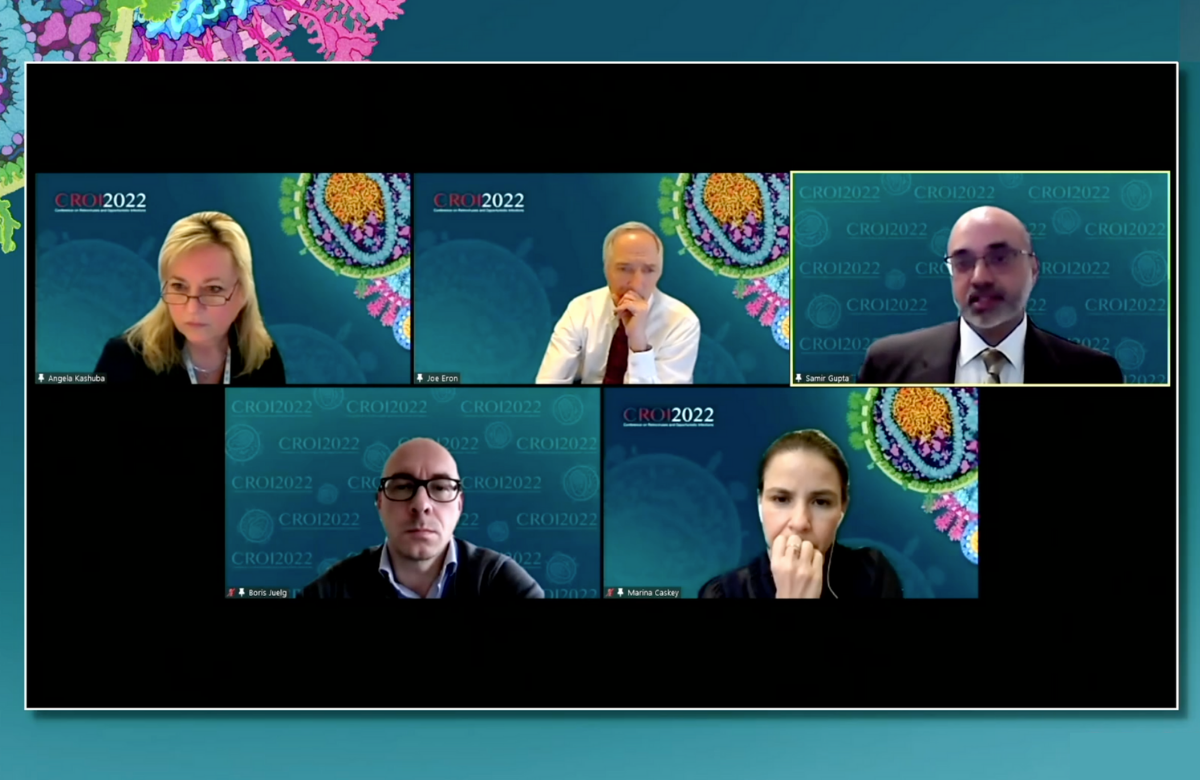 Professor Samir Gupta (top right) at CROI 2022. | ||
|
Lenacapavir disrupts the HIV capsid, the cone-shaped shell that surrounds the viral genetic material, and interferes with multiple stages of the HIV lifecycle. Because it works differently from existing drugs, it remains active against virus that has developed resistance to other antiretroviral classes. The phase II CALIBRATE trial is evaluating lenacapavir as a component of first-line treatment. At CROI, Professor Samir Gupta of Indiana University presented week 54 results: 90% of participants in treatment group 1 (receiving injections of lenacapavir every six months with daily oral TAF – tenofovir alafenamide) and 85% each in treatment groups 2 (lenacapavir injections every six months with daily oral bictegravir) and 3 (daily lenacapavir tablets plus TAF/emtricitabine) had a viral load below 50, as did 92% of those in the control group (daily oral bictegravir/TAF/emtricitabine). Along with high rates of viral suppression, people in all four groups saw similar CD4 count increases: 206, 212, 220 and 193 cells, respectively. Treatment with lenacapavir was generally safe and well-tolerated. The phase II/III CAPELLA trial is evaluating lenacapavir in heavily treatment-experienced people. It enrolled 72 people with resistance to at least two drugs from three of the four major antiretroviral classes. They were currently on antiretroviral therapy but unable to maintain viral suppression and about two-thirds had a CD4 count below 200. The first 36 participants were randomly assigned to add either oral lenacapavir or a placebo to their failing regimen for 14 days. Then everyone was offered lenacapavir given by subcutaneous injection every six months plus an optimised background regimen selected based on resistance testing. Another 36 people in a non-randomised open-label cohort received lenacapavir plus an optimised background regimen from the outset, starting with a 14-day oral lead-in before switching to injections. At last year’s CROI, researchers reported that after the initial 14-day period, 88% of participants in the lenacapavir group experienced at least a 0.5 log drop in viral load, compared with 17% in the placebo group. A poster at this year’s CROI gave updated results. In the open-label cohort, at 26 weeks, 81% of people had a viral load below 50. In the randomised cohort, at 52 weeks, 83% of participants had a viral load below 50. Over time, the proportion of people with a very low CD4 count (below 50) fell from 22% to 3%, while the proportion with an adequate count (200 or higher) steadily rose, from 25% to 60%. Findings from these two studies show that lenacapavir has the potential to be used as a component of a long-acting treatment regimen, but there are currently no other antiretrovirals that can be given at such a long interval. Studies of twice-yearly lenacapavir injections for PrEP are currently underway. | ||
Have HIV-associated neurological disorders declined due to newer antiretrovirals? | ||
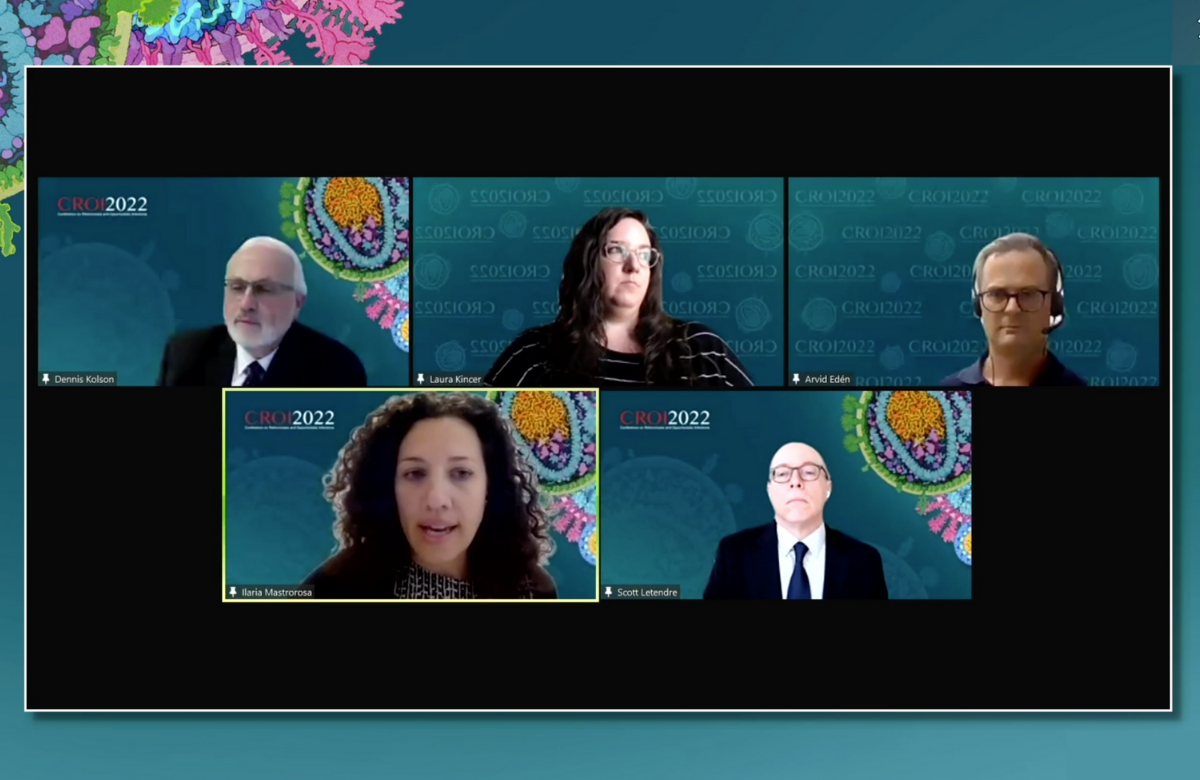 Dr Ilaria Mastrorosa (bottom left) at CROI 2022. | ||
|
HAND is diagnosed using tests of functions such as attention and working memory, mental processing speed, memory, and fine motor skills. Dr Ilaria Mastrorosa and colleagues analysed the neurocognitive profiles of 1365 people living with HIV in Italy and receiving antiretroviral therapy between 2009 and 2020. Most participants were male, in their forties and fifties, and the median time since HIV diagnosis was ten years. Overall in the study, HAND prevalence was 22%. It decreased over time from 38% in 2009-2011 to 16% in 2018-2020. Unsurprisingly, the prevalence of HAND was much higher among participants who presented with a deficit of memory, attention or concentration (40%) than in other participants (13%). Lower rates of HAND were associated with younger age, more education, a higher current CD4 count and testing in recent years. Lower rates were also seen in people taking dual therapies and integrase inhibitor-based regimens, suggesting a potential role of antiretrovirals that have greater virological efficacy and are more tolerable. | ||
Injected PrEP: breakthrough cases could have been detected sooner | ||
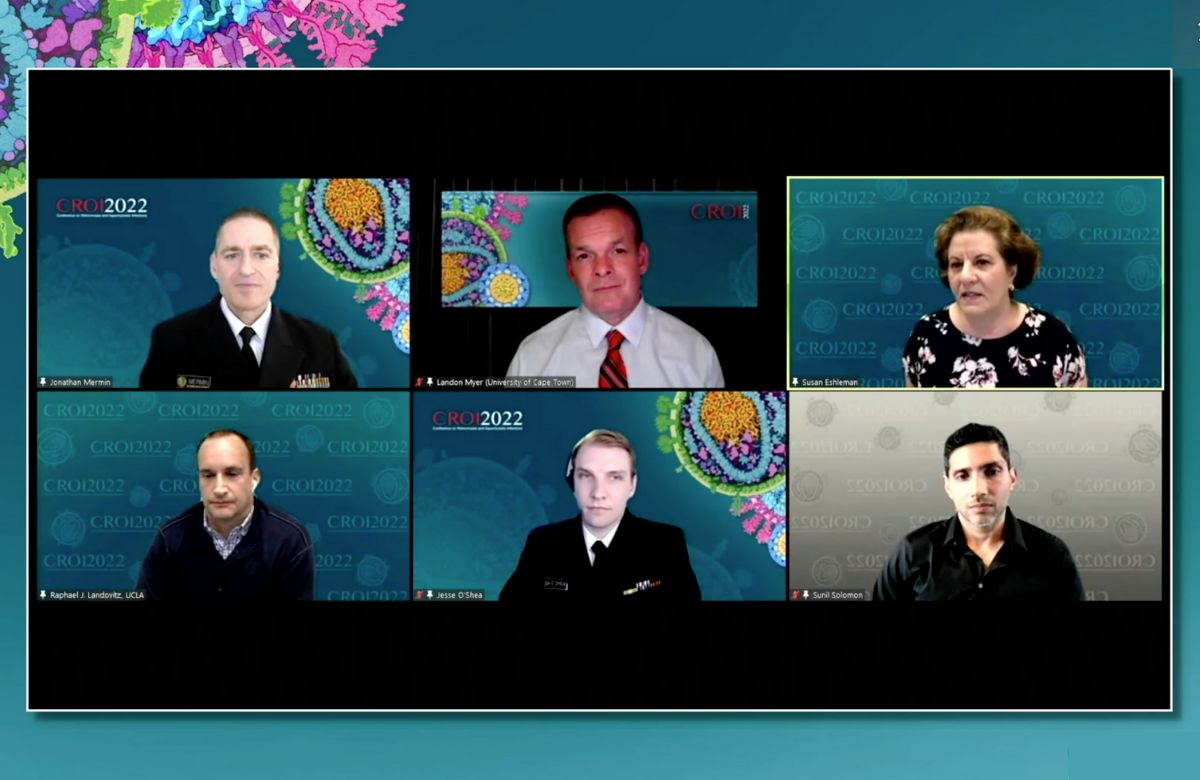 Professor Susan Eshleman (top right) at CROI 2022. | ||
|
In the rare cases where people acquire HIV despite taking PrEP, the medication can suppress replication of the virus and delay the production of antibodies, making these breakthrough infections hard to detect. The result of delayed diagnosis can be the development of drug resistance, potentially limiting future treatment options. There are now over four years of data from the HPTN 083 study and it continues to show that injected cabotegravir PrEP every two months is 66% more effective at preventing HIV infections than daily oral PrEP in gay and bisexual men and transgender women. There have only been 25 infections among 2244 people taking cabotegravir over a period of 4.4 years, most due to lapses in adherence. The conference was given a detailed analysis of six cases in which resistance mutations to cabotegravir were later discovered. Four were breakthrough cases in people who had their PrEP injections on time. One was a participant who acquired HIV during the ‘lead-in’ period of five weeks on oral cabotegravir pills. The last already had undiagnosed HIV when he started the study. Testing for HIV in the study involved a rapid, point-of-care test which, if positive or indeterminate, was then confirmed by a lab antibody/antigen test. However, retrospective testing was also conducted using two PCR assays that can detect HIV RNA – which means they can detect HIV infection before antibodies to HIV start being made. Retrospective testing found that in the six cases examined, the first time HIV RNA could be detected was between 3 and 20 weeks earlier than the HIV rapid antibody test. Use of an RNA assay for HIV screening would have detected infection before mutations associated with major resistance to integrase inhibitors were detected in four cases, or before additional major resistance-associated mutations developed in two further cases. | ||
Broadly neutralising antibody treatment: is pre-existing resistance its Achilles heel? | ||
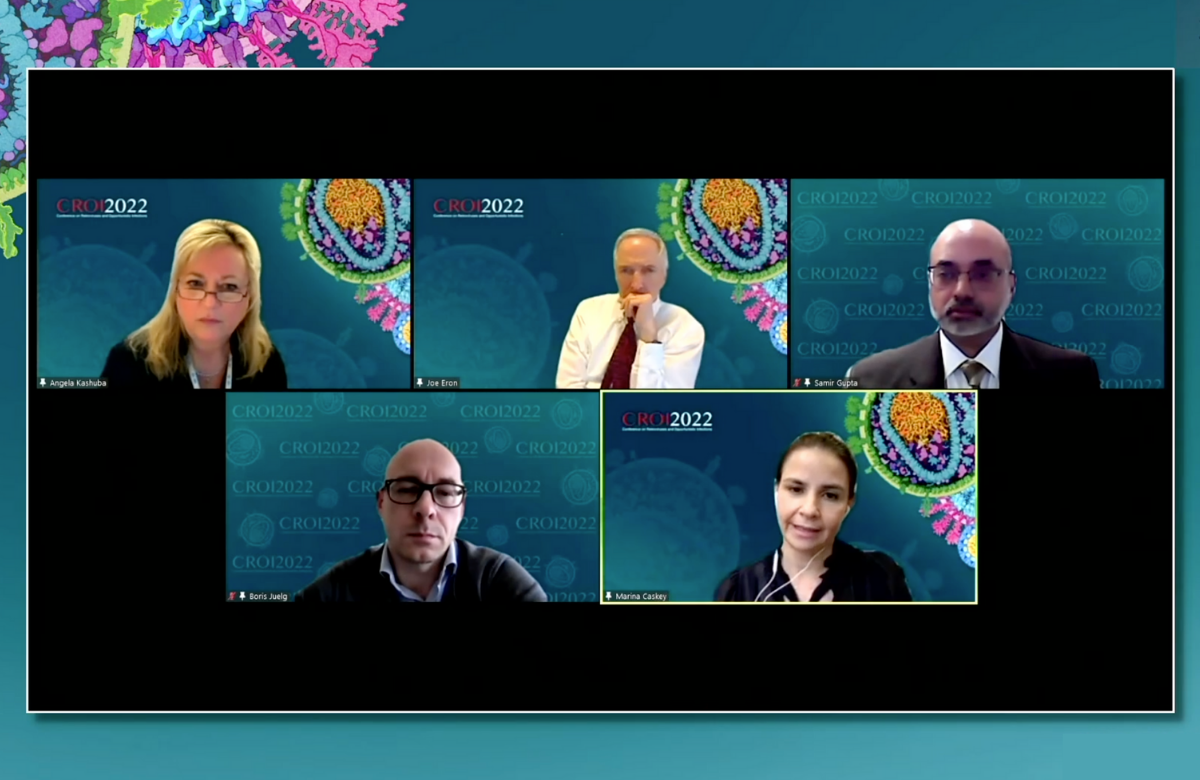 Dr Boris Juelg (bottom left) and Dr Marina Caskey (bottom right) at CROI 2022. | ||
|
The two studies only included ten people in total. One study gave participants who were not taking ART a combination of three antibodies (PGDM 1400, PGT 121, and VRC07-523-LS) and the other study two long-acting ones (10-1074-LS and 3BNC117-LS). Between the two studies, three of the participants were able to achieve and maintain an undetectable viral load for periods of several months on bNAb treatment alone. However, six others saw their viral loads initially decline, but return to baseline level after two to four weeks. In both studies, the crucial predictor of virological failure was whether people had HIV with pre-existing resistance to one or more of the bNAbs. The results suggest that resistance tests may be required to determine who can benefit from bNAb treatment. Session chair Professor Joe Eron commented that the state of current bNAb therapy resembled the early days of antiretroviral therapy, where the effectiveness of treatment was often rapidly compromised by resistance. It was necessary to develop more drugs from multiple drug classes and a similar move may be needed for bNAbs. | ||
aidsmapLIVE: Decades of HIV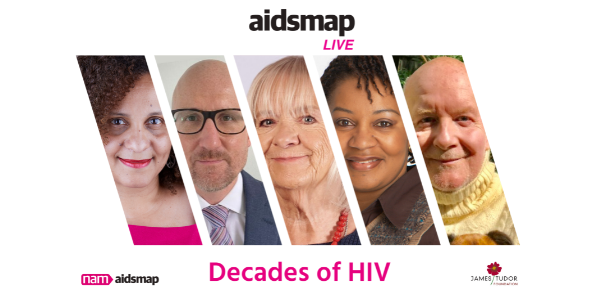
On Monday 28 February at 5pm (UK time), NAM aidsmap is broadcasting its first aidsmapLIVE of 2022. aidsmapLIVE is a series of panel discussions streamed live on NAM aidsmap's Facebook and Twitter pages. ‘Decades of HIV’ will explore issues around ageing with HIV, experiences of living with HIV over many years and ways that people with HIV can look after their health. NAM aidsmap’s Susan Cole will be talking to guests Dr Tristan Barber, HIV doctor at The Royal Free Hospital with expertise in ageing issues; Jo Josh, communications adviser at the British HIV Association; Rebecca Mbewe, co-director of the 4M Mentor Mothers Network; and George Hodson, long-term HIV survivor. | ||
Connect with us |
||
|
NAM's news coverage of CROI 2022 has been made possible thanks to support from Gilead Sciences Europe Ltd and ViiV Healthcare. |
||
|
aidsmap is an award-winning, community-based organisation, which works from the UK. We deliver reliable and accurate HIV information across the world to HIV-positive people and to the professionals who treat, support and care for them.
NAM Publications
Cally Yard, 439 Caledonian Road, London N7 9BG Company limited by guarantee. Registered in England & Wales, number: 2707596 Registered charity, number: 1011220 To unsubscribe please click here Privacy Policy: www.aidsmap.com/about-us/confidentiality |